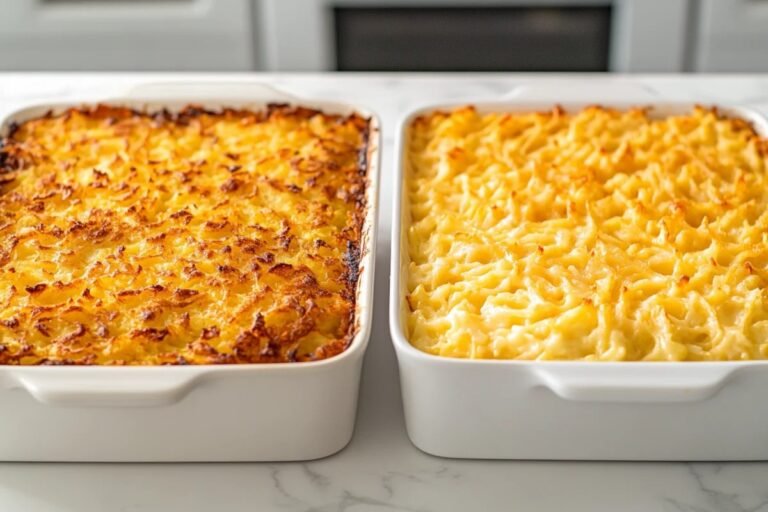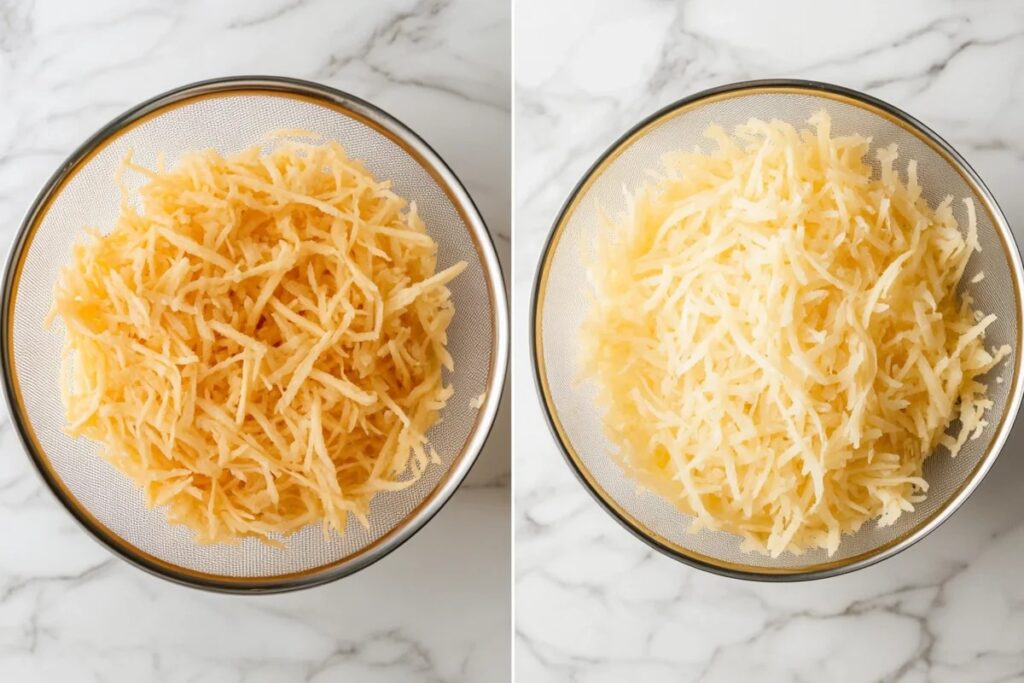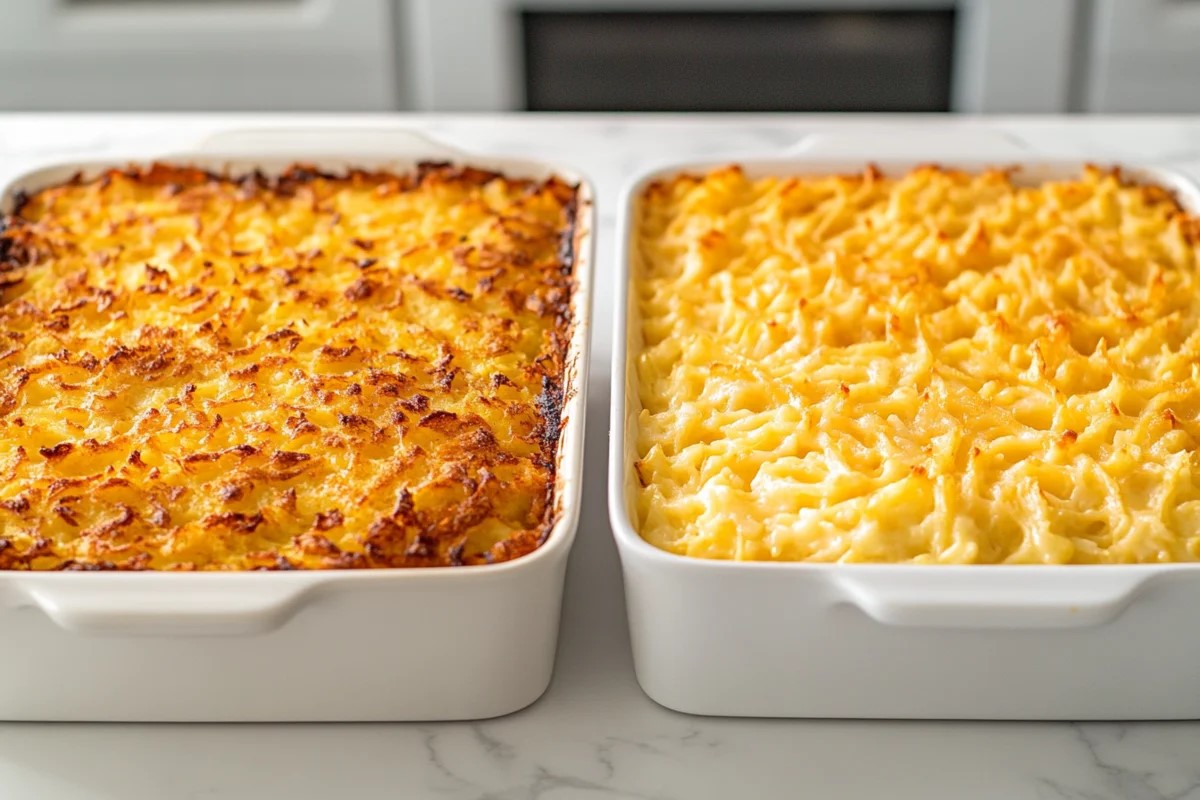Hash brown casseroles are a classic comfort food, loved for their crispy texture and rich, cheesy goodness. But when it comes to making them, one question often arises: Do I have to thaw frozen hash browns for casserole? Some recipes call for thawed potatoes, while others suggest using them straight from the freezer. So, which method is best?
In this guide, we’ll break down whether you really need to thaw frozen hash browns before using them. We’ll also cover the pros and cons of both methods, how to properly thaw hash browns, and ways to prevent a soggy casserole. Plus, we’ll answer some of the most common questions about frozen hash browns in casseroles.
Let’s dive in!
Print
Do I Have to Thaw Frozen Hash Browns for Casserole?
This classic hash brown casserole uses thawed potatoes for a crisp, golden top and creamy, cheesy center—perfect for breakfast or dinner.
- Total Time: 60 minutes
- Yield: 6 servings 1x
Ingredients
4 cups thawed shredded hash browns
1 cup shredded cheddar cheese
1/2 cup sour cream
1/4 cup melted butter
1/2 cup diced onions
1/2 teaspoon garlic powder
1/2 teaspoon salt
1/2 teaspoon black pepper
1 cup crushed cornflakes (optional, for topping)
Instructions
1. Preheat oven to 375°F (190°C). Grease a baking dish with butter or cooking spray.
2. Squeeze out excess moisture from thawed hash browns using a clean towel.
3. In a large bowl, mix hash browns, cheese, sour cream, melted butter, onions, and seasonings until well combined.
4. Spread the mixture evenly in the prepared baking dish.
5. If using a topping, sprinkle crushed cornflakes over the casserole for extra crunch.
6. Bake for 40–45 minutes until golden brown and crispy on top.
7. Let it rest for 5 minutes before serving.
Notes
You can prepare the mix in advance and refrigerate it overnight.
Crushed Ritz crackers or breadcrumbs can replace cornflakes for topping.
- Prep Time: 15 minutes
- Cook Time: 45 minutes
- Category: Casserole
- Method: Baking
- Cuisine: American
- Diet: Vegetarian
Nutrition
- Serving Size: 1 cup
- Calories: 320
- Sugar: 2g
- Sodium: 620mg
- Fat: 20g
- Saturated Fat: 10g
- Unsaturated Fat: 8g
- Trans Fat: 0g
- Carbohydrates: 28g
- Fiber: 2g
- Protein: 9g
- Cholesterol: 55mg
Should You Thaw Frozen Hash Browns Before Using Them?
What Happens If You Use Frozen Hash Browns Directly?
If you’ve ever wondered whether you can just toss frozen hash browns into a casserole, the short answer is yes—but with some caveats. When you use them straight from the freezer, a few things can happen:
- Uneven Cooking – Since frozen hash browns contain ice crystals, they can cook unevenly. Some parts might stay cold while others overcook.
- Excess Moisture – Ice trapped in the potatoes melts during baking, which can lead to a watery casserole.
- Longer Cooking Time – Your casserole will need extra time to cook since you’re starting with frozen ingredients.
While some recipes are designed for frozen hash browns, thawing them first can help avoid these issues.
Benefits of Thawing Frozen Hash Browns for Casserole
So, why should you consider thawing your hash browns before using them? Here are a few key benefits:
- Better Texture – Thawed hash browns crisp up more easily, giving your casserole a perfect golden-brown crust.
- Even Cooking – No more half-cooked or mushy sections—thawed hash browns cook uniformly.
- Moisture Control – Thawing allows you to remove excess water, preventing a soggy dish.
- Shorter Cooking Time – Since they’re already at room temperature, your casserole bakes faster.
When Can You Skip Thawing?
While thawing is usually the best option, some scenarios allow you to skip it:
- If the recipe has a longer bake time – A slow-baking casserole (45+ minutes) can handle frozen hash browns.
- If you’re using pre-shredded, lightly frozen hash browns – Some brands have minimal ice buildup, making them fine to use as-is.
- If you want a softer texture – If you prefer a softer, creamier casserole, frozen hash browns may actually work better.
Pros and Cons of Using Frozen vs. Thawed Hash Browns in Casserole
Pros of Using Frozen Hash Browns in a Casserole
Many recipes suggest using frozen hash browns straight from the freezer. Here’s why:
- Convenience – No need to plan ahead or spend time defrosting. Just grab the bag and start cooking.
- Longer Shelf Life – Frozen hash browns stay fresh for months, reducing food waste.
- Softer Texture – If you prefer a softer, creamier casserole, frozen hash browns might work better.
- Ideal for Slow Cooking – When baking at low temperatures for a long time, the extra moisture in frozen potatoes can prevent the casserole from drying out.
Cons of Using Frozen Hash Browns in a Casserole
Of course, using frozen hash browns comes with some downsides:
- Uneven Cooking – The potatoes might not heat evenly, leaving some parts undercooked.
- Soggy Casserole – Excess water from ice crystals can make the dish watery.
- Longer Baking Time – Your casserole may need extra minutes in the oven to cook through.
Pros of Thawing Hash Browns Before Cooking
On the other hand, thawing hash browns first offers several benefits:
- Crispier Texture – Thawed potatoes brown better, creating a crispy, golden crust.
- Better Absorption – When mixed with cheese, eggs, or seasonings, thawed potatoes absorb flavors more effectively.
- Even Cooking – No cold spots or overcooked sections. Everything bakes consistently.
- Reduces Cooking Time – A thawed casserole bakes faster since there’s no extra ice to melt.
Cons of Thawing Hash Browns Before Cooking
However, thawing isn’t always necessary. Here are a few drawbacks:
- Extra Step – If you’re in a hurry, waiting for hash browns to thaw can slow you down.
- Risk of Spoilage – If not cooked promptly after thawing, hash browns can develop bacteria.
- Potential Dryness – Without the moisture from frozen hash browns, the casserole could turn out dry.
Ultimately, whether or not you thaw depends on your preferred texture, time constraints, and recipe instructions. If you want a crispier, well-cooked casserole, thawing is best. But if you prefer a creamier, softer dish, using frozen might be just fine.
How to Properly Thaw Frozen Hash Browns
The Best Methods for Thawing Hash Browns
If you’ve decided that thawing is the way to go, here are the best methods:
1. Refrigerator Thawing (Best for Even Defrosting)
- Place the frozen hash browns in a bowl and cover them.
- Let them thaw in the fridge for 8-12 hours or overnight.
- Drain any excess liquid before using them in your recipe.
Why it works: This method ensures a gradual, even thaw without making the potatoes mushy.
2. Microwave Thawing (Quickest Method)
- Place hash browns in a microwave-safe bowl.
- Use the defrost setting or microwave in 30-second bursts, stirring in between.
- Pat dry with a paper towel to remove moisture.
Why it works: This is the fastest way to thaw hash browns, though it requires careful monitoring to prevent overheating.
3. Room Temperature Thawing (Good for Short Timeframes)
- Spread the frozen hash browns in a single layer on a baking sheet.
- Let them sit at room temperature for 30–60 minutes.
- Drain any excess water before using.
Why it works: This method is faster than fridge thawing but safer than microwaving.
4. Thawing in a Colander (Best for Moisture Control)
- Place hash browns in a colander over the sink.
- Let them sit for an hour, shaking occasionally to remove excess ice.
- Press with a paper towel or kitchen towel to squeeze out extra moisture.
Why it works: This helps prevent a soggy casserole by ensuring the hash browns are as dry as possible.
How Long Does It Take to Thaw Hash Browns?
The time depends on the method you use:
- Refrigerator: 8-12 hours
- Microwave: 2-3 minutes
- Room Temperature: 30-60 minutes
- Colander Method: 1 hour
Can You Speed Up the Thawing Process?
If you’re in a hurry, try these tricks:
- Use warm (not hot) water. Place the bag of hash browns in a sealed plastic bag and submerge in warm water for 15-20 minutes.
- Spread them out. A single layer thaws faster than a thick pile.
- Use a paper towel. Pat dry excess moisture to speed up drying.
By using the right thawing method, you can ensure your hash brown casserole comes out crispy, golden, and flavorful.
Common Issues with Frozen Hash Browns in Casseroles

Why Is My Hash Brown Casserole Soggy?
One of the biggest complaints when using frozen hash browns in a casserole is excess moisture. This can lead to a watery, mushy dish instead of the crispy, golden-brown perfection you want.
The most common reasons for a soggy hash brown casserole include:
- Using frozen hash browns without thawing – Ice crystals melt into the casserole, adding too much water.
- Not draining thawed hash browns – Even after thawing, hash browns hold a lot of moisture.
- Overloading the casserole with dairy – Too much milk, cheese, or cream can make it dense and wet.
- Baking at the wrong temperature – Cooking at too low a temperature may not allow excess liquid to evaporate.
How to Prevent Excess Moisture in a Casserole
To avoid a soggy casserole, follow these simple tips:
- Thaw hash browns completely before mixing them into the dish.
- Press out excess water using a clean kitchen towel or paper towels.
- Bake uncovered to allow moisture to escape.
- Use the right ratio of ingredients—too much liquid leads to a dense casserole.
- Bake at 375-400°F (190-200°C) for a crispy, golden top.
Do You Need to Squeeze Water Out of Thawed Hash Browns?
Yes! Even after thawing, hash browns retain a lot of water. To get rid of excess moisture:
- Place thawed hash browns in a clean kitchen towel or layered paper towels.
- Squeeze firmly to remove as much liquid as possible.
- Let them sit for a few minutes and repeat if needed.
This simple step prevents a watery casserole and ensures a crispier texture.
Best Practices for Using Frozen Hash Browns in Casserole Recipes
Choosing the Right Type of Hash Browns
Not all hash browns are the same! Here’s how to pick the best one for your casserole:
- Shredded Hash Browns – Best for a crispy texture and even cooking.
- Diced Hash Browns – Ideal for heartier casseroles with a chunky texture.
- Hash Brown Patties – Work well when crumbled into a casserole but may need extra thawing.
Look for low-moisture frozen hash browns to avoid excess water in your dish.
The Ideal Cooking Temperature and Time
To get that crispy, golden-brown casserole, follow these baking guidelines:
- Oven Temperature – Bake at 375-400°F (190-200°C) to allow moisture to evaporate.
- Cooking Time – Bake for 40-50 minutes, depending on the recipe.
- Use a Higher Rack – Placing the dish on a higher oven rack promotes browning.
For an extra crispy top, broil the casserole for the last 2-3 minutes.
Combining Ingredients for the Perfect Texture
Balancing ingredients is key! Here’s what works best:
- Eggs & Cheese – Helps bind the casserole while adding creaminess.
- Sour Cream or Greek Yogurt – Adds richness without making it watery.
- Seasonings & Herbs – Garlic powder, onion powder, and paprika enhance flavor.
- Crunchy Toppings – Crushed cornflakes, breadcrumbs, or extra cheese can create a crispy topping.
Final Tips for a Perfect Hash Brown Casserole
- Preheat the oven before baking to ensure even cooking.
- Drain all excess moisture from thawed hash browns before mixing.
- Don’t overmix—stirring too much can break down the potatoes and make them mushy.
- Let it rest after baking—give your casserole 5-10 minutes before cutting to help it set.
With these best practices, your hash brown casserole will turn out crispy, golden, and flavorful every time!
Looking for another comforting meal? Try this Ground Beef Hash Brown Casserole, which combines seasoned beef, creamy cheese, and crispy hash browns for a satisfying dish!
Hash Brown Casserole Recipe: Should You Thaw or Not?
Recipe 1: Using Thawed Hash Browns

If you want a crispy, golden-brown casserole, thawing your hash browns first is the best approach. This method reduces excess moisture and ensures even cooking.
Ingredients:
- 4 cups thawed shredded hash browns
- 1 cup shredded cheddar cheese
- 1/2 cup sour cream
- 1/4 cup melted butter
- 1/2 cup diced onions
- 1/2 teaspoon garlic powder
- 1/2 teaspoon salt
- 1/2 teaspoon black pepper
- 1 cup crushed cornflakes (optional, for topping)
Instructions:
- Preheat oven to 375°F (190°C). Grease a baking dish with butter or cooking spray.
- Squeeze out excess moisture from thawed hash browns using a clean towel.
- In a large bowl, mix hash browns, cheese, sour cream, melted butter, onions, and seasonings until well combined.
- Spread the mixture evenly in the prepared baking dish.
- If using a topping, sprinkle crushed cornflakes over the casserole for extra crunch.
- Bake for 40-45 minutes until golden brown and crispy on top.
- Let it rest for 5 minutes before serving.
Recipe 2: Using Frozen Hash Browns
If you’re short on time, you can still make a delicious, creamy casserole using frozen hash browns.
Adjustments:
- Increase baking time by 10-15 minutes to account for frozen potatoes.
- Cover the dish with foil for the first 20 minutes to help it cook evenly.
- Consider adding an extra 1/4 cup of cheese for more structure.
This method works best if you don’t mind a softer texture rather than a crispy top.
So, do I have to thaw frozen hash browns for casserole? If you want a crispy, well-cooked dish, yes! But if you prefer a softer, creamier texture, frozen hash browns can still work.
For another delicious variation, check out this Chicken and Hash Brown Casserole Recipe, which pairs crispy hash browns with tender chicken for a hearty meal!
Final Verdict – Should You Thaw Frozen Hash Browns for Casserole?
So, do I have to thaw frozen hash browns for casserole? The answer depends on the texture you want and the time you have.
When to Thaw Hash Browns
Thawing hash browns is the best choice when you want a crispy, golden-brown casserole. It helps:
- Prevent excess moisture that can make the dish soggy.
- Ensure even cooking so all ingredients heat properly.
- Reduce baking time, making your dish ready faster.
If crispiness is a priority, take a few extra minutes to thaw and drain the hash browns before mixing them into your recipe.
When You Can Skip Thawing
On the other hand, using frozen hash browns directly can work in some cases, such as:
- When making a slow-cooked casserole where extra moisture won’t ruin the texture.
- If you prefer a softer, creamier hash brown casserole.
- When you’re short on time and need to get dinner in the oven quickly.
If using frozen hash browns, be prepared to adjust the cooking time by adding 10-15 extra minutes. Also, consider baking uncovered to allow moisture to evaporate.
for more recipes follow our facebook page
Conclusion
A great hash brown casserole comes down to texture and technique. Whether you thaw or not depends on your preference:
- If you love a crispy, golden top, thawing is the way to go.
- If you don’t mind a softer, creamier dish, frozen hash browns will still work.
So, next time you’re wondering, Do I have to thaw frozen hash browns for casserole?—think about the final texture you want. Either way, following the right baking methods will help you achieve the perfect balance of flavors and textures.
Now that you know all the best tips and tricks, it’s time to put them to the test! Try a thawed vs. frozen experiment and see which method works best for your taste buds.
FAQS
Do Hash Browns Have to Be Thawed for Casserole?
Not necessarily! While thawing helps with crispiness and even cooking, some recipes are designed to work with frozen hash browns. If using frozen, be prepared for a longer bake time and extra moisture.
Do You Need to Thaw Frozen Hash Browns Before Cooking?
If you’re frying hash browns or making a casserole that needs a crispy texture, thawing is the way to go. But do I have to thaw frozen hash browns for casserole in every case? Not necessarily! If your dish is saucy, slow-cooked, or baked for an extended period, you might be able to use frozen potatoes without any issues. However, if you want even cooking and a golden-brown, crispy top, it’s always best to thaw frozen hash browns for casserole before baking.
Why Is My Hash Brown Casserole Soggy?
A soggy casserole usually happens due to excess moisture from frozen hash browns. To fix this:
Thaw and drain hash browns before baking.
Bake uncovered to allow moisture to evaporate.
Use the right oven temperature—375-400°F (190-200°C) is ideal.
How Do You Get Moisture Out of Frozen Hash Browns?
After thawing, place hash browns in a clean towel and squeeze out as much liquid as possible. You can also let them sit in a colander for 15-20 minutes to drain naturally.
